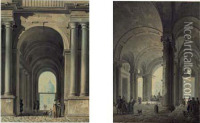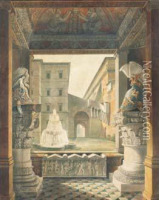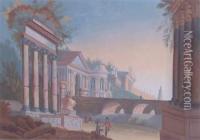Louis Pierre Baltard Paintings
Louis Pierre Baltard was a prominent French architect and engraver, born in Paris in 1764. His career spanned a period of significant transformation in French architecture, from the neoclassical era through to the beginnings of modern urbanism in Paris under Napoleon III. Baltard is perhaps best known for his work on public buildings and his role in the architectural development of Paris in the early 19th century. His contributions to architecture were not only in terms of individual buildings but also in his visionary urban planning ideas, which would later influence the modernization of Paris.
Baltard studied architecture under his father, who was also an architect, and at the École des Beaux-Arts in Paris, where he honed his skills and developed his architectural vision. Early in his career, he won the prestigious Prix de Rome in 1788, which allowed him to study in Rome at the French Academy, an experience that greatly influenced his architectural style and philosophy. Upon returning to France, Baltard embarked on a series of public commissions, which included churches, prisons, and market halls, showcasing his versatility and commitment to serving the public through architecture.
One of Baltard's most significant contributions was his work on the Palais de Justice in Paris, where he was involved in the restoration and expansion of this crucial judicial complex. However, he is perhaps best remembered for the design and construction of the twelve pavilions of the Les Halles market, completed in the 1850s. Although these iconic structures were demolished in the 1970s to make way for the modern shopping center, they were celebrated for their innovative use of iron and glass, marking a departure from traditional stone construction and anticipating future trends in architecture.
Beyond his architectural works, Baltard was also an accomplished engraver and teacher. He published several influential works on architecture and engraving, contributing to the theoretical and educational foundations of the field. His engravings, which often depicted architectural landmarks and urban scenes, were highly regarded for their detail and accuracy, serving as valuable documents of Parisian architecture and urban life in his time.
Louis Pierre Baltard passed away in 1846, leaving behind a legacy that reflected the transition from neoclassical to modern architecture. His vision and contributions to French architecture were instrumental in shaping the urban landscape of Paris, influencing generations of architects and urban planners. His work remains a testament to the enduring power of architecture to reflect and facilitate societal change.





